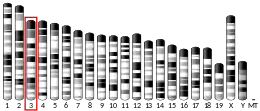HAPLN2
Hyaluronan and proteoglycan link protein 2 (HAPLN2) also known as brain link protein 1 (BRAL1) is a protein that in humans is encoded by the HAPLN2 gene.[5] HAPLN1 codes for a related link protein that is expressed in cartilage while Bral1 is expressed in brain.
| HAPLN2 | |||||||||||||||||||||||||
|---|---|---|---|---|---|---|---|---|---|---|---|---|---|---|---|---|---|---|---|---|---|---|---|---|---|
| Identifiers | |||||||||||||||||||||||||
| Aliases | HAPLN2, BRAL1, hyaluronan and proteoglycan link protein 2 | ||||||||||||||||||||||||
| External IDs | MGI: 2137300 HomoloGene: 11045 GeneCards: HAPLN2 | ||||||||||||||||||||||||
| |||||||||||||||||||||||||
| |||||||||||||||||||||||||
| |||||||||||||||||||||||||
| Orthologs | |||||||||||||||||||||||||
| Species | Human | Mouse | |||||||||||||||||||||||
| Entrez | |||||||||||||||||||||||||
| Ensembl | |||||||||||||||||||||||||
| UniProt | |||||||||||||||||||||||||
| RefSeq (mRNA) | |||||||||||||||||||||||||
| RefSeq (protein) | |||||||||||||||||||||||||
| Location (UCSC) | Chr 1: 156.62 – 156.63 Mb | Chr 3: 88.02 – 88.03 Mb | |||||||||||||||||||||||
| PubMed search | [3] | [4] | |||||||||||||||||||||||
| Wikidata | |||||||||||||||||||||||||
| |||||||||||||||||||||||||
Function
Bral1 interacts with versican and brevican in nodes of Ranvier. In mice with reduced Bralp1 expression the extracellular matrix at nodes of Ranvier is disrupted and action potential conduction is abnormal.[6]
References
- GRCh38: Ensembl release 89: ENSG00000132702 - Ensembl, May 2017
- GRCm38: Ensembl release 89: ENSMUSG00000004894 - Ensembl, May 2017
- "Human PubMed Reference:". National Center for Biotechnology Information, U.S. National Library of Medicine.
- "Mouse PubMed Reference:". National Center for Biotechnology Information, U.S. National Library of Medicine.
- "Entrez Gene: hyaluronan and proteoglycan link protein 2".
- Bekku Y, Vargová L, Goto Y, Vorísek I, Dmytrenko L, Narasaki M, Ohtsuka A, Fässler R, Ninomiya Y, Syková E, Oohashi T (Feb 2010). "Bral1: its role in diffusion barrier formation and conduction velocity in the CNS". The Journal of Neuroscience. 30 (8): 3113–23. doi:10.1523/JNEUROSCI.5598-09.2010. PMC 6633924. PMID 20181608.
Further reading
- Spicer AP, Joo A, Bowling RA (Jun 2003). "A hyaluronan binding link protein gene family whose members are physically linked adjacent to chondroitin sulfate proteoglycan core protein genes: the missing links". The Journal of Biological Chemistry. 278 (23): 21083–91. doi:10.1074/jbc.M213100200. PMID 12663660.
- Kähler AK, Djurovic S, Rimol LM, Brown AA, Athanasiu L, Jönsson EG, Hansen T, Gústafsson O, Hall H, Giegling I, Muglia P, Cichon S, Rietschel M, Pietiläinen OP, Peltonen L, Bramon E, Collier D, St Clair D, Sigurdsson E, Petursson H, Rujescu D, Melle I, Werge T, Steen VM, Dale AM, Matthews RT, Agartz I, Andreassen OA (Jan 2011). "Candidate gene analysis of the human natural killer-1 carbohydrate pathway and perineuronal nets in schizophrenia: B3GAT2 is associated with disease risk and cortical surface area". Biological Psychiatry. 69 (1): 90–6. doi:10.1016/j.biopsych.2010.07.035. PMID 20950796. S2CID 30133148.
- Nomoto H, Oohashi T, Hirakawa S, Ueki Y, Ohtsuki H, Ninomiya Y (Feb 2002). "Human BRAL1 and BCAN genes that belong to the link-module superfamily are tandemly arranged on chromosome 1q21-23". Acta Medica Okayama. 56 (1): 25–9. PMID 11873941.
- Martins-de-Souza D, Gattaz WF, Schmitt A, Rewerts C, Marangoni S, Novello JC, Maccarrone G, Turck CW, Dias-Neto E (Mar 2009). "Alterations in oligodendrocyte proteins, calcium homeostasis and new potential markers in schizophrenia anterior temporal lobe are revealed by shotgun proteome analysis". Journal of Neural Transmission. 116 (3): 275–89. doi:10.1007/s00702-008-0156-y. PMID 19034380.
- Oohashi T, Hirakawa S, Bekku Y, Rauch U, Zimmermann DR, Su WD, Ohtsuka A, Murakami T, Ninomiya Y (Jan 2002). "Bral1, a brain-specific link protein, colocalizing with the versican V2 isoform at the nodes of Ranvier in developing and adult mouse central nervous systems". Molecular and Cellular Neurosciences. 19 (1): 43–57. doi:10.1006/mcne.2001.1061. PMID 11817897. S2CID 23568217.
- Hirakawa S, Oohashi T, Su WD, Yoshioka H, Murakami T, Arata J, Ninomiya Y (Oct 2000). "The brain link protein-1 (BRAL1): cDNA cloning, genomic structure, and characterization as a novel link protein expressed in adult brain". Biochemical and Biophysical Research Communications. 276 (3): 982–9. doi:10.1006/bbrc.2000.3583. PMID 11027579.
- Sim H, Hu B, Viapiano MS (Sep 2009). "Reduced expression of the hyaluronan and proteoglycan link proteins in malignant gliomas". The Journal of Biological Chemistry. 284 (39): 26547–56. doi:10.1074/jbc.M109.013185. PMC 2785343. PMID 19633295.
This article is issued from Wikipedia. The text is licensed under Creative Commons - Attribution - Sharealike. Additional terms may apply for the media files.



